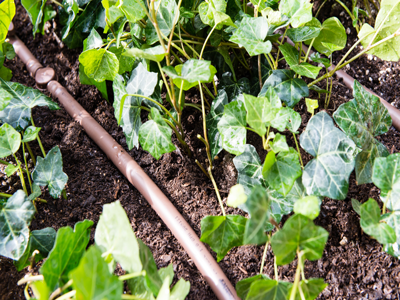This chart can help determine the spacing you need for your soil type.
| SOIL TYPE | SAND | LOAM | CLAY | |
|---|---|---|---|---|
| Emitter Distribution | ||||
| Saturation Rate | in/hr | .75 - 1.25 | .25 - .75 | .15 - .25 |
| mm/hr | 19 - 32 | 6 - 19 | 4 - 6 | |
| Diameter of Coverage | ft | 1 - 3 | 2 - 4 | 3 - 6 |
| m | .3 - .91 | .6 - 1.2 | 1 - 1.8 | |
| Available Water | in/ft | 1.4 | 2 | 2.5 |
| mm/m | 0.11 | 0.16 | 0.2 | |
For Example: In sandy soils, Hunter typically suggests using 1.0 GPH emitters spaced every 12 inches on the tubing. Install the tubing in rows 12 inches apart for proper coverage. For clay soils, you can use a lower flow rate (0.6 GPH) and increased (18 inch) emitter spacing. Likewise you should increase your row spacing to 18 inches to allow for the greater diameter of coverage.
Different soils yield different "wetted" patterns, for proper coverage you'll need to consider your soil type. Sandy soils do not allow the water to spread laterally from the emitter. Conversely, clay soil is "tight" and water will spread further away from each emitter.

Metric Specifiers
The AW, better WHC = water holding capacity should for irrigation purposes be expressed as millimeters per meter of soil because the amount of water available to plants depends on this value and the roots depths.
Despite presenting this value as a percentage it is also correct for irrigation purposes to show AW as mm/m of soil, as it helps the user to calculate the optimal irrigation duration per irrigation event depending on soil type and depth of the absorbing roots.
For Example: AW would be 50mm/m, absorbing roots (of e.g. bushes) shall develop in a depth of 30-50cm. After the calculation of the optimal application rate, the user would know that he/she should not apply more water per irrigation event than an amount that would fill up the soil moisture to more than 25mm at maximum. This water will soak below the 50cm depth of the roots and be a waste of water.
WHC (Water Holding Capacity): Available soil moisture, this is the difference in the soils water content/field capacity and permanent wilting point. It is also the soil water that is available for plants to use.
Still need help? We're here.
Tell us what you need support with and we'll find the best solution for you.

